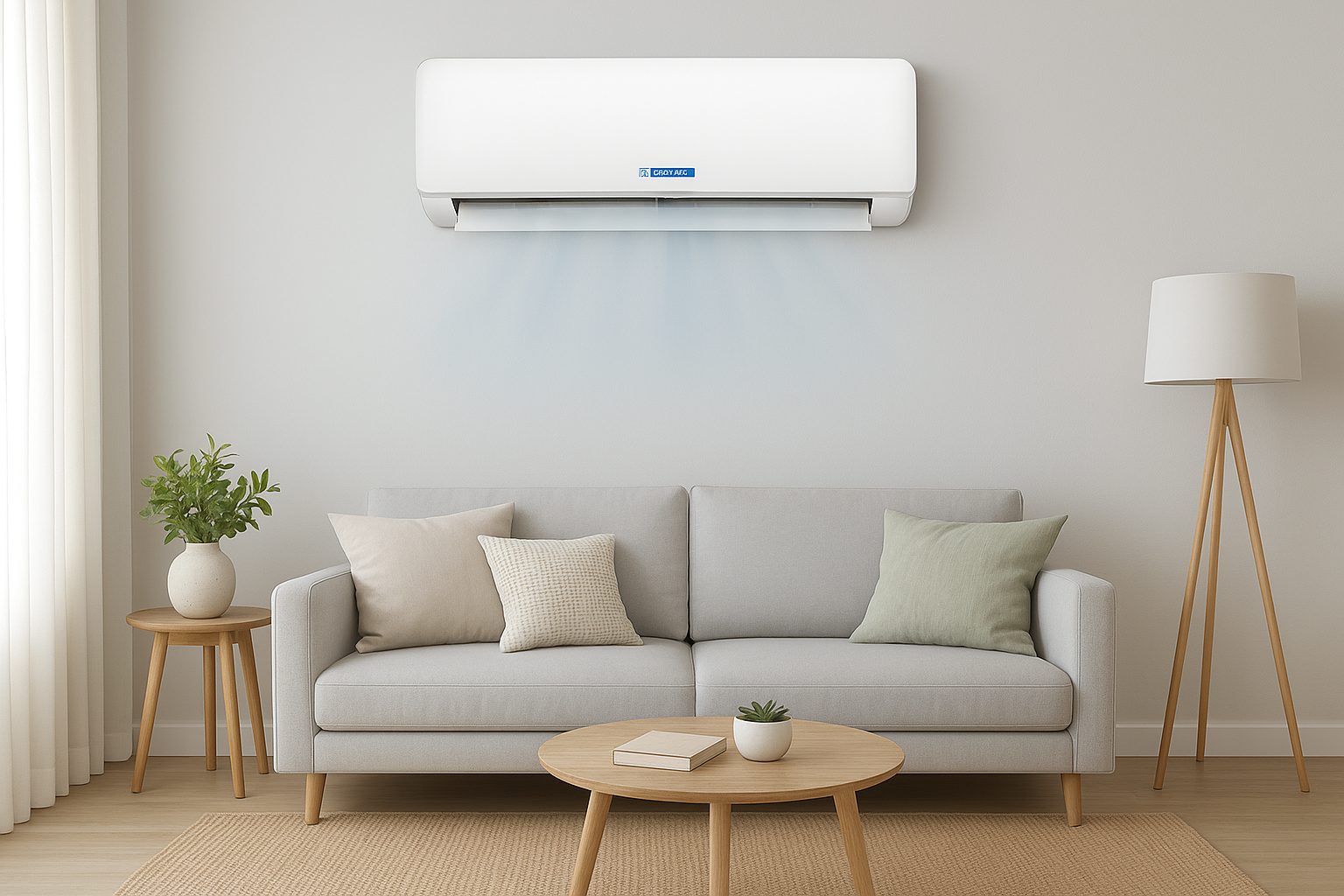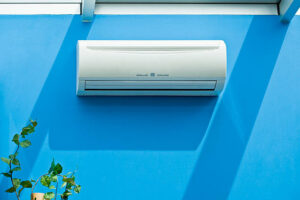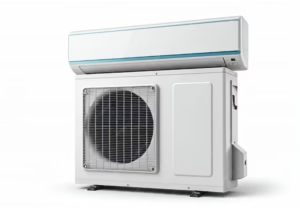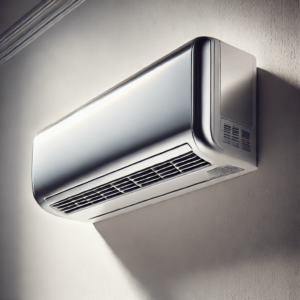Introduction
When it comes to keeping your small room cool and comfortable, picking the right air conditioner is crucial. It’s not just about cooling power; you need energy efficiency, noise level, and features that fit your lifestyle. That’s where Blue Star AC Models for Small Rooms shine. Known for their durability, energy savings, and smart features, Blue Star offers a range of options for every budget.
Why Choose Blue Star AC Models for Small Rooms?
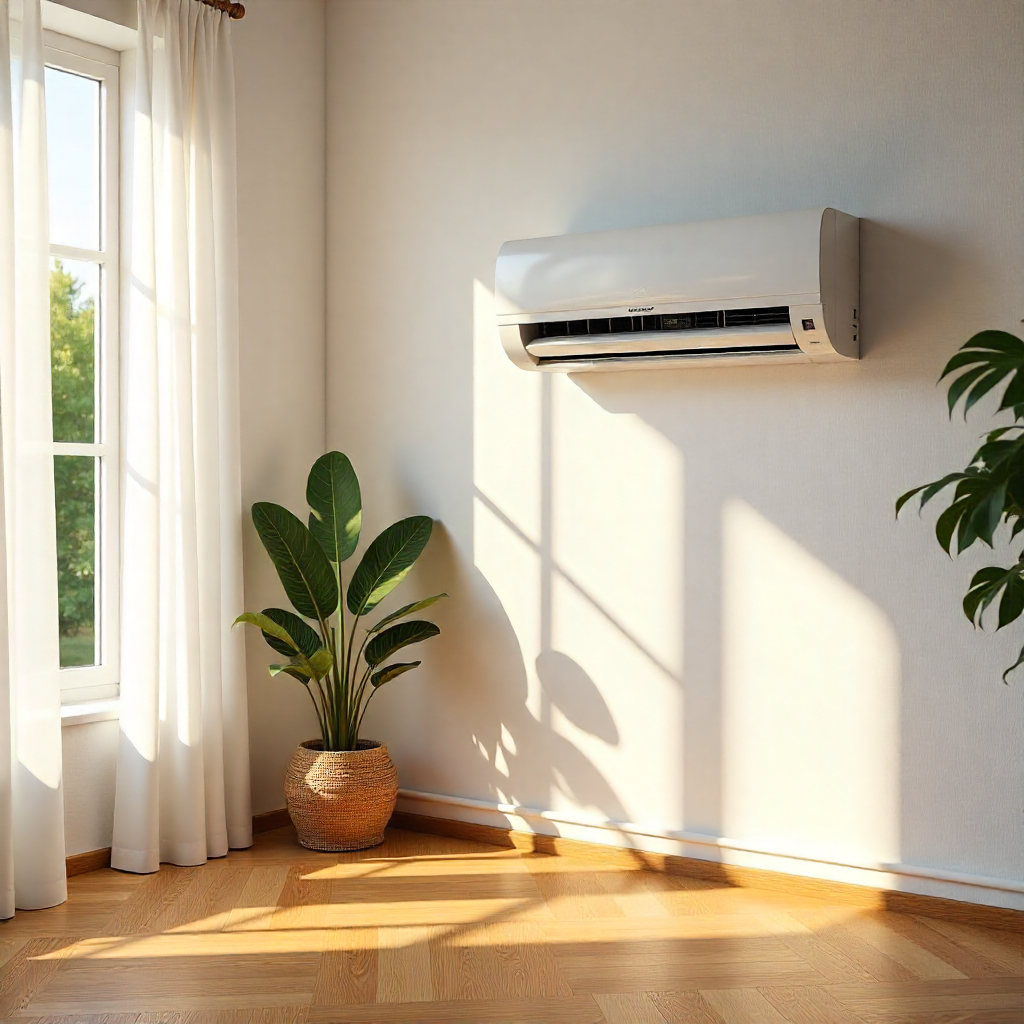
A small room might seem easy to cool, but picking the wrong AC can lead to:
- High electricity bills
- Uneven cooling
- Constant noise disturbance
- Reduced lifespan of the AC
Blue Star AC Models for Small Rooms have earned a reputation for being energy-efficient, durable, and reliable. Whether you’re looking for a fixed speed or inverter model, Blue Star has something that meets your needs. The brand’s advanced technology ensures your small room remains cool without spiking your electricity bill. To know more read our How to Choose the Right Blue Star AC – Best guide in 2025 article.
Factors to Consider When Selecting Blue Star AC Models for Small Rooms
Before buying a Blue Star AC, keep your room and usage needs in mind. Following are the key considerations:
1. Cooling Capacity
For Blue Star AC Models for Small Rooms, cooling capacity typically ranges from 0.8 to 1 ton. A 1-ton capacity is ideal for small to medium rooms of up to 150 sq. ft.
2. Energy Efficiency
When selecting Blue Star AC Models for Small Rooms, look for higher energy ratings (preferably 4-5 stars). This ensures your AC is efficient and keeps electricity costs low while offering optimal cooling.
3. Noise Levels
Noise levels are crucial in small rooms where the air conditioner might be close to your workspace or bed. Choose Blue Star AC Models for Small Rooms that are designed to operate quietly for a peaceful environment.
4. Air Purification and Filtering
- Look for anti-bacterial, dust, and HEPA filters.
- Reduces allergies and provides clean air in sealed environments.
5. Additional Features
- Sleep Mode – adjusts temperature at night
- Turbo Mode – quick cooling during hot afternoons
- Self-Diagnosis – simplifies troubleshooting
- Wi-Fi Smart Control – remote operation from anywhere
How to Choose the Right AC Capacity for Your Room
Selecting the correct AC capacity is the most crucial thing if you are working with a small-sized room. Selecting an incorrect capacity leads to inefficient cooling, wastage of energy, and hassle. The good news is that with Blue Star AC Models for Small Rooms, there is some scope for adjustment—but have to know how to do the right fit calculations between your room and the AC.
Step 1: Measure Your Room
Start with exact measurements:
- Length (L) – wall to wall
- Width (W) – across
- Height (H) – floor to ceiling
Example:
- Length = 12 ft
- Width = 10 ft
- Height = 9 ft
Step 2: Calculate Room Area and Volume
- Room Area (sq. ft.) = Length × Width
- 12 × 10 = 120 sq. ft.
- Room Volume (cubic ft.) = Length × Width × Height
- 12 × 10 × 9 = 1080 cubic ft.
- Notice that AC tonnage is area-based. Use volume when working at ceiling heights over 9–10 ft. check out our article to Understand the Blue Star AC Tonnage
Step 3: Use Cooling Capacity Guidelines
The following is an approximate guideline for a small room:
| AC Capacity | Room Size Recommendation |
| 0.8 Ton | 100–120 sq. ft. |
| 1 Ton | 120–150 sq. ft. |
| 1.5 Ton | 150–200 sq. ft. |
Example:
- Room = 100 sq. ft. → 0.8 Ton AC sufficient
- Room = 120 sq. ft. → 1 Ton AC recommended
Step 4: Check Ceiling Height
High ceilings need a slight additional boost in cooling capacity because there is additional air to be cooled in them.
Rule: Boost capacity by 10–15% if ceilings are over 9 ft.
Example:
- Room = 120 sq. ft., ceiling = 11 ft
- Base AC = 1 Ton
- Adjusted AC = 1.1–1.2 Ton → take the closest available size (1 Ton will do in most scenarios, inverter ideal)
- you can calculate your room size before choose the ac.
Step 5: Consider Sunlight and Orientation of the Room
Sunlight will play a significant role in your AC’s efficiency:
- East direction rooms: morning sun, medium adjustment
- West direction rooms: sun. afternoon. warmer → take inverter AC for energy conservation
- South direction rooms: sun exposure by day → can be in need of proper insulation or greater capacity
Pro Tip: Blind or curtain insulate to lower heat load and increase efficiency.
Step 6: Account for Insulation and Room Usage
Other parameters may impact your AC selection:
- Poor insulation → greater retention of heat → moderately increased AC capacity
- High-occupancy rooms (3–4 people) → include 0.25 Ton recommended
- Electronic-intensive rooms → additional heat → utilize inverter AC for optimization
Step 7: Final AC Capacity Choice
Take all factors into final consideration:
Example Scenario:
- Room = 140 sq. ft., ceiling = 10 ft, west direction, 2 people
- Base AC = 1 Ton
- Adjust for sunlight/occupancy = +0.1–0.2 Ton
- Recommended AC: 1 Ton Blue Star inverter AC for max comfort and efficiency
Small Room Quick Tips
- Don’t oversized; short-cycling lowers comfort and wastes energy.
- Inverter ACs adjust to varying room conditions, conserving energy.
- Utilize curtains, blinds, or insulated windows for maximum cooling efficiency.
- Position AC wisely to provide even air flow throughout the room.
Top Blue Star AC Models for Small Rooms
Here are some of the best Blue Star AC Models for Small Rooms that combine excellent performance with energy savings.
1 Blue Star 0.8 Ton 3 Star Fixed Speed Window AC
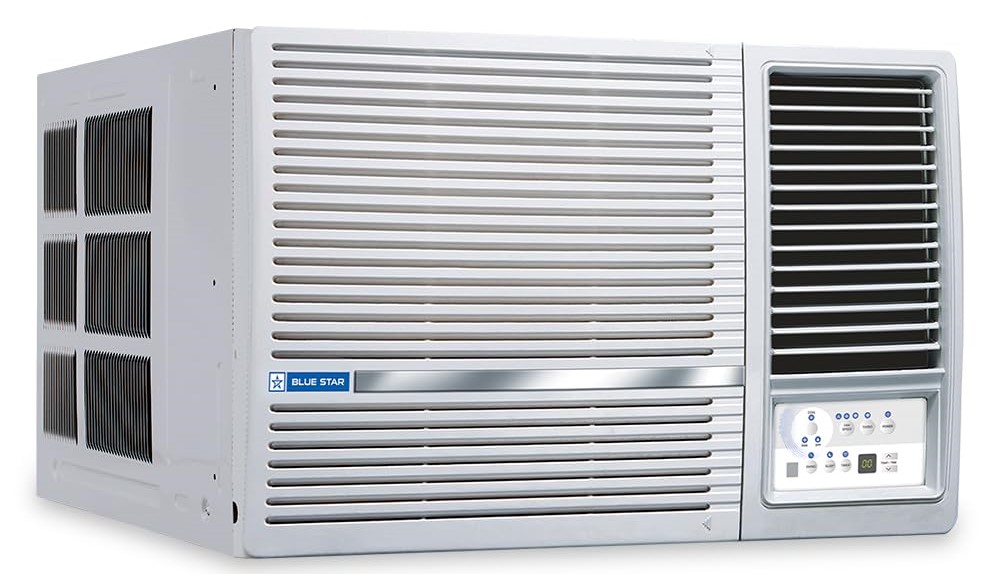
Perfect for small rooms, this 0.8-ton window AC is energy-efficient and offers powerful cooling.
Key Features:
- Cooling Capacity: 0.8 Ton
- Energy Rating: 3 Star
- Condenser: Copper
- Special Features: Turbo Cool, Sleep Mode, Anti-Freeze Thermostat
Pros:
- Suitable for small rooms
- Efficient cooling with Turbo Cool
- Affordable pricing for Blue Star AC Models for Small Rooms
Cons:
- Fixed speed operation limits flexibility
- Less energy-efficient than inverter models
2 Blue Star 1 Ton 3 Star Fixed Speed Window AC
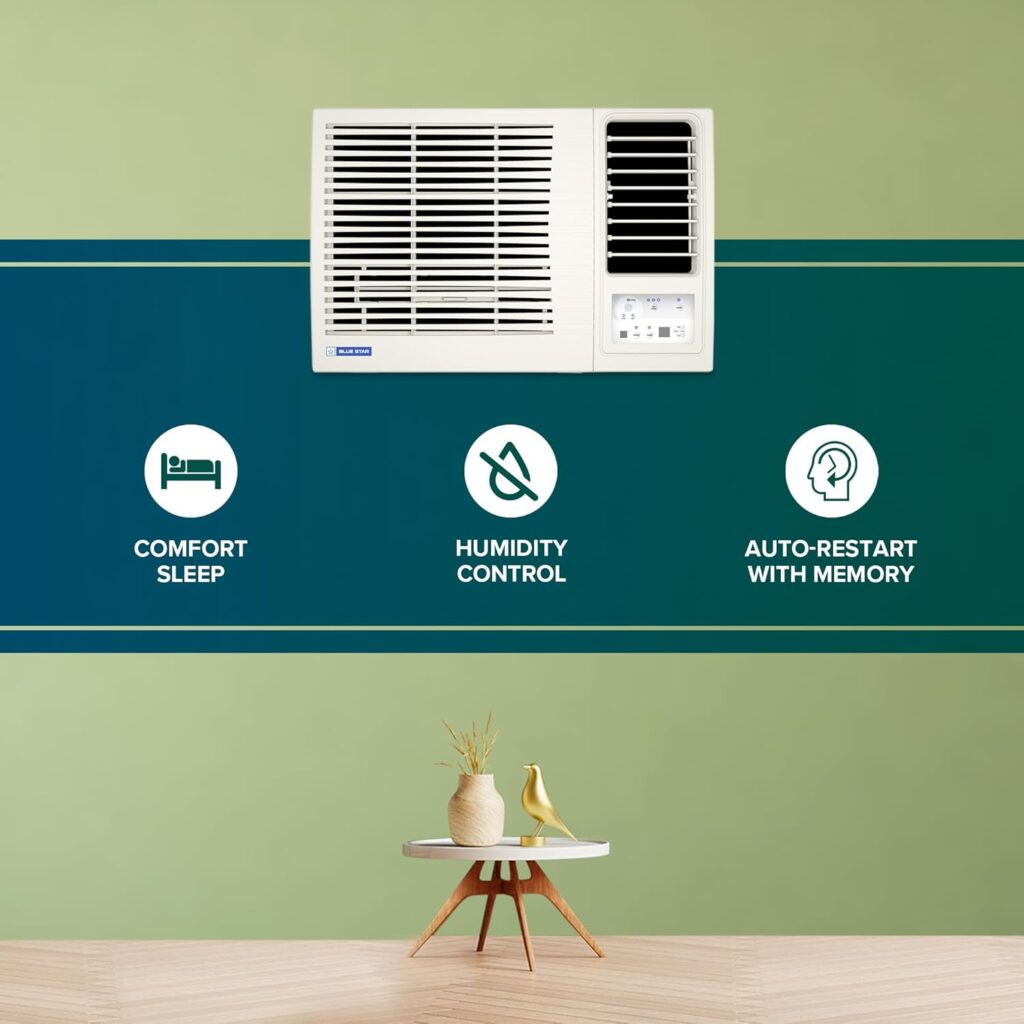
For rooms up to 120 sq. ft., this 1-ton window AC offers solid cooling and reliability, making it one of the most popular Blue Star AC Models for Small Rooms.
Key Features:
- Cooling Capacity: 1 Ton
- Energy Rating: 3 Star
- Condenser: Copper
- Special Features: Turbo Cool, Sleep Mode, Self-Diagnosis
Pros:
- Ideal for small to medium rooms
- Reliable cooling performance
- Quick installation of Blue Star AC Models for Small Rooms
Cons:
- Fixed speed might not be suitable for fluctuating temperatures
- Not as energy-efficient as inverter models
3 Blue Star 1 Ton 5 Star Inverter Split AC
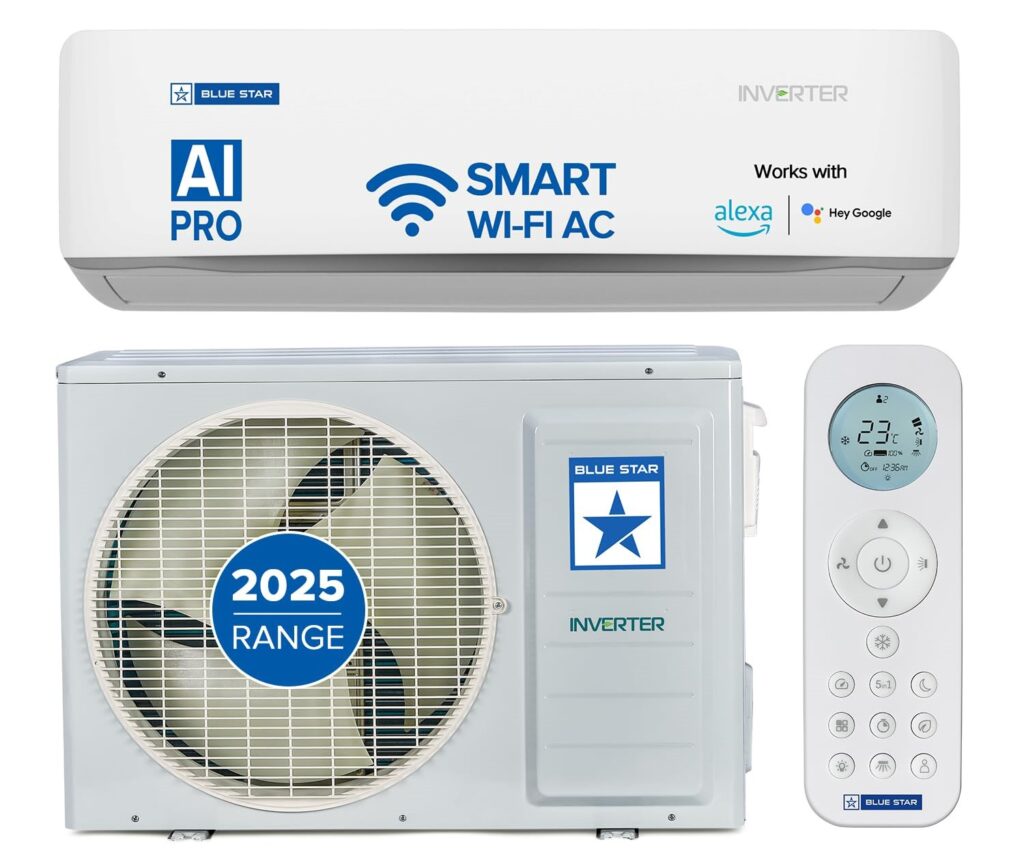
One of the best Blue Star AC Models for Small Rooms when energy efficiency is a priority, this inverter split AC offers lower running costs and consistent performance.
Key Features:
- Cooling Capacity: 1 Ton
- Energy Rating: 5 Star
- Condenser: Copper
- Special Features: Inverter Compressor, Self-Diagnosis, Multi-Stage Filtration
Pros:
- Inverter technology ensures consistent cooling
- Energy-efficient with a 5-star rating
- Ideal for long-term savings on electricity bills
Cons:
- Higher upfront cost compared to fixed-speed models
- Installation requires professional assistance
4 Blue Star 1 Ton 3 Star Convertible 5-in-1 Cooling Inverter Split AC
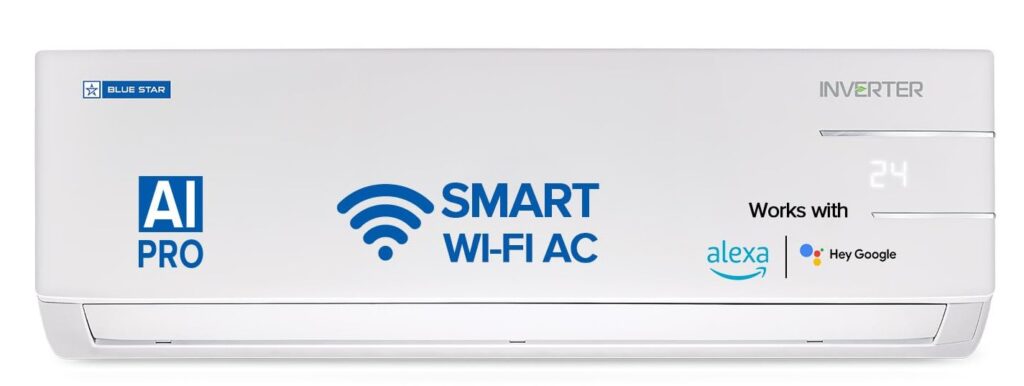
This versatile model stands out among Blue Star AC Models for Small Rooms by offering five different cooling modes, ensuring flexibility based on your cooling needs.
Key Features:
- Cooling Capacity: 1 Ton
- Energy Rating: 3 Star
- Condenser: Copper
- Special Features: 5-in-1 Convertible Cooling, Inverter Compressor, Self-Diagnosis
Pros:
- Multiple cooling options for personalized comfort
- Energy-efficient inverter compressor
- Excellent for varying room temperatures in small spaces
Cons:
- Slightly complex controls for first-time users
- Higher cost than basic models
Comparative Analysis of the Top Models
| Model | Cooling Capacity | Energy Rating | Condenser | Special Features |
|---|---|---|---|---|
| Blue Star 0.8 Ton 3 Star Window AC | 0.8 Ton | 3 Star | Copper | Turbo Cool, Sleep Mode |
| Blue Star 1 Ton 3 Star Window AC | 1 Ton | 3 Star | Copper | Turbo Cool, Sleep Mode, Self-Diagnosis |
| Blue Star 1 Ton 5 Star Inverter Split AC | 1 Ton | 5 Star | Copper | Inverter Compressor, Self-Diagnosis, Filtration |
| Blue Star 1 Ton 3 Star Convertible Split AC | 1 Ton | 3 Star | Copper | 5-in-1 Convertible Cooling, Inverter Compressor |
Inverter vs Non-Inverter AC: Small Rooms
Choosing Blue Star AC Models for Small Rooms is one of the choices where choosing an inverter AC versus a non-inverter (fixed speed) AC is one of the most important decisions. Both have their advantages, but understanding how they function and when to use them can cost you money, energy, and grief.
Advantages of Inverter ACs
Inverter ACs adaptively change the speed of the compressor based on the room temperature through advanced technology, as opposed to the on/off mechanism of traditional ACs. Following are the reasons why they are most ideal for small rooms:
Energy Efficiency
- The variable-speed compressor draws only as much power as is required to maintain the desired temperature.
- This can lead to 30–40% savings in electricity costs compared to non-inverter ACs, as long as the AC is run for 6–8 hours daily.
Regular Cooling and Comfort
- Since the compressor modulates round the clock, room temperature remains steady, avoiding abrupt hot and cold outbursts.
- Small rooms are assisted as temperature fluctuation becomes noticeable in small rooms.
Lower Noise Operation
- Inverter AC operates at lower speeds after the room reaches the desired temperature.
- Noise lowers significantly, usually between 35–40 dB, and is most suitable for bedrooms or home office usage.
Longer Lifespan with Less Wear & Tear
- Fixed-speed ACs run consistently on and off, putting additional stress on the compressor.
- Inverter ACs avoid constant cycling, reducing wear and extending the lifespan of the unit.
Perfect for Hotter Environments
In small rooms exposed to afternoon sun or poor insulation, inverter ACs control heat spikes effectively without wastage of energy.
Example:
A 1 Ton 5-Star Blue Star inverter AC running 8 hours a day in a 120 sq. ft. west-facing room can save ₹500–₹700 a month on electricity compared to a similar non-inverter model.
When Non-Inverter ACs Are Sufficient
Non-inverter ACs (fixed speed) are simpler and have their own advantages in certain scenarios:
Short-Term or Occasional Use
If the AC is used 1–3 hours daily, the efficiency of an inverter AC may not be justified by the extra initial cost.
Budget-Conscious Buyers
Inverter ACs are more expensive initially, but non-inverter ACs are best suited for small rooms with few cooling requirements.
Simpler Technology and Maintenance
- Fewer electronic components make fixed-speed ACs simpler and cheaper to repair.
- It is less likely to experience technical glitches compared to inverter types.
Small Spaces in Milder Climates
In mild summer regions or rooms not exposed to the direct sun, a non-inverter 0.8–1 Ton AC may suffice for cooling the space.
Example:
A Blue Star 0.8 Ton 3-Star window AC for a 100 sq. ft. bedroom used mostly in the evening may operate well without an inverter.
Quick Comparison Table: Inverter vs Non-Inverter ACs
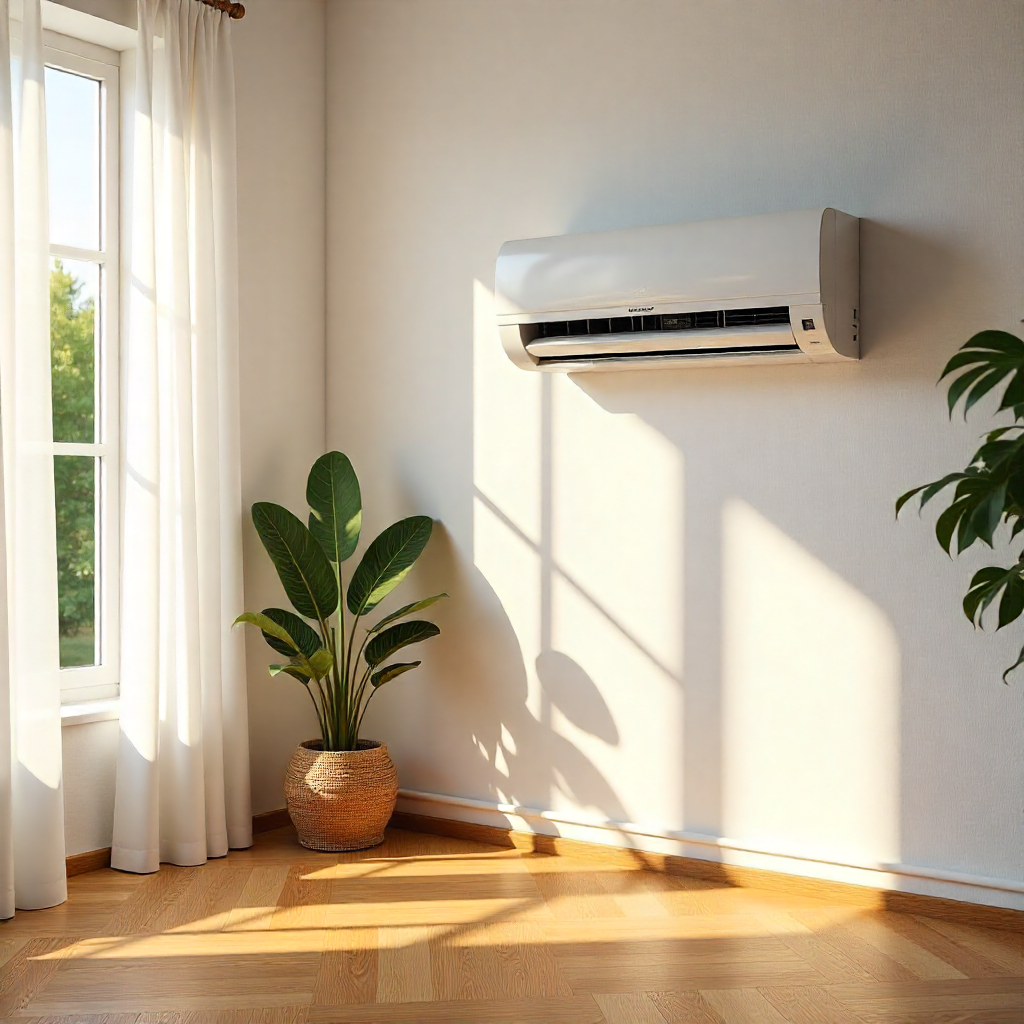
| Feature | Inverter AC | Non-Inverter AC |
| Energy Consumption | Variable, saves energy | Fixed, higher consumption |
| Cooling Comfort | Steady temperature | Frequent on/off, temperature swings |
| Noise Level | Quieter (35–40 dB) | Louder (45–50 dB) |
| Upfront Cost | Higher | Lower |
| Lifespan | Longer due to less wear | Moderate |
| Best For | Continuous use, hot rooms, bedrooms | Occasional use, budget-conscious buyers |
Pro Tip for Small Rooms:
- If your room is occupied during the day or gets direct sunlight, an inverter AC is worth the investment.
- For infrequent usage in shaded rooms, a non-inverter AC is good enough.
Noise, Cooling Speed, and Performance Tests
In choosing an AC for a bedroom or small house, it’s not all about comfort — cooling speed, noise level, and seasonal performance must also be considered. They can make all the difference between a peaceful night’s sleep and a constant hum. Let’s analyze:
1.Noise Level (Decibels Matter More Than You Think)
For small rooms, where you’re sitting or sleeping close to the AC, even a small difference is noticeable.
Ideal Noise Levels for Bedrooms
- Under 40 dB = Quiet enough for peaceful sleep (like a library).
- 40–45 dB = Noticeable hum, but tolerable for most people.
- 50 dB+ = Can feel intrusive, especially at night.
Blue Star Advantage
- Most Blue Star inverter split ACs also feature “Silent Mode,” reducing compressor and fan noise to 35–38 dB, just perfect for bedrooms, nurseries, and home office rooms.
- Window ACs are typically 45–55 dB, which while fine for a living room, isn’t quite so heavenly in sleeping areas.
Pro Tip: When buying, always check dB rating if noise sensitive. A 2–3 dB difference can be more than you’d realize in a small space.
2.Cooling Rate (Turbo Mode vs. Normal Mode)
Cooling rate is especially needed for Indian summer, especially if the room is warm and instant cooling relief is needed.
Turbo/Quick Cool Mode
- Runs the compressor and fan at high speed to cool quickly.
- Can cool room temperature down by 3–5°C in just 10–15 minutes.
- Suitable for afternoons or when there are guests of surprise.
- Drawback: Consumes more power during operation.
- Suitable for longer durations like sleep during the night.
Saves power compared to Turbo Mode.
Blue Star Feature Highlight: iFeel feature in certain models keeps track of temperature not just at the unit, but even around the remote, for faster and more focused cooling for small rooms.
3.Seasonal Performance (ACs’ Performance Under Varying Conditions)
ACs do not work equally all year round. Small rooms are affected more by seasonal conditions, so technology does matter.
Peak Summer (March–June)
- Inverter ACs change compressor speed smoothly, avoiding power peaks.
- Non-inverter ACs will operate heavily during summer, leading to constant on/off cycles and irregular cooling.
Monsoons (July–September)
- Humidity is a lesser problem than temperature.
- Blue Star ACs with dry mode or dehumidifier remove excess moisture, not letting a person get wet and sticky.
Mild Winters (October–February)
- In regions where there is a need for heating, models that support heat pump feature provide both heating and cooling and are hence operational throughout the year.
Quick Comparison Snapshot
| Factor | Inverter Split AC | Non-Inverter Split AC | Window AC |
| Noise Levels | 35–40 dB (silent) | 45–50 dB | 45–55 dB |
| Cooling Speed | Steady & fast with Turbo | Good but less efficient | Quick initial cool but noisy |
| Seasonal Performance | Efficient in all weathers | Works well only in moderate use | Limited humidity control |
Bottom Line: Blue Star inverter split AC performs best on noise comfort, cooling efficiency, and year-round performance for small study rooms and bedrooms. Non-inverter or window types could be a consideration in budget models, but compromising on noise or energy efficiency in the long run.
Installation Tips – Blue Star AC Models for Small Rooms
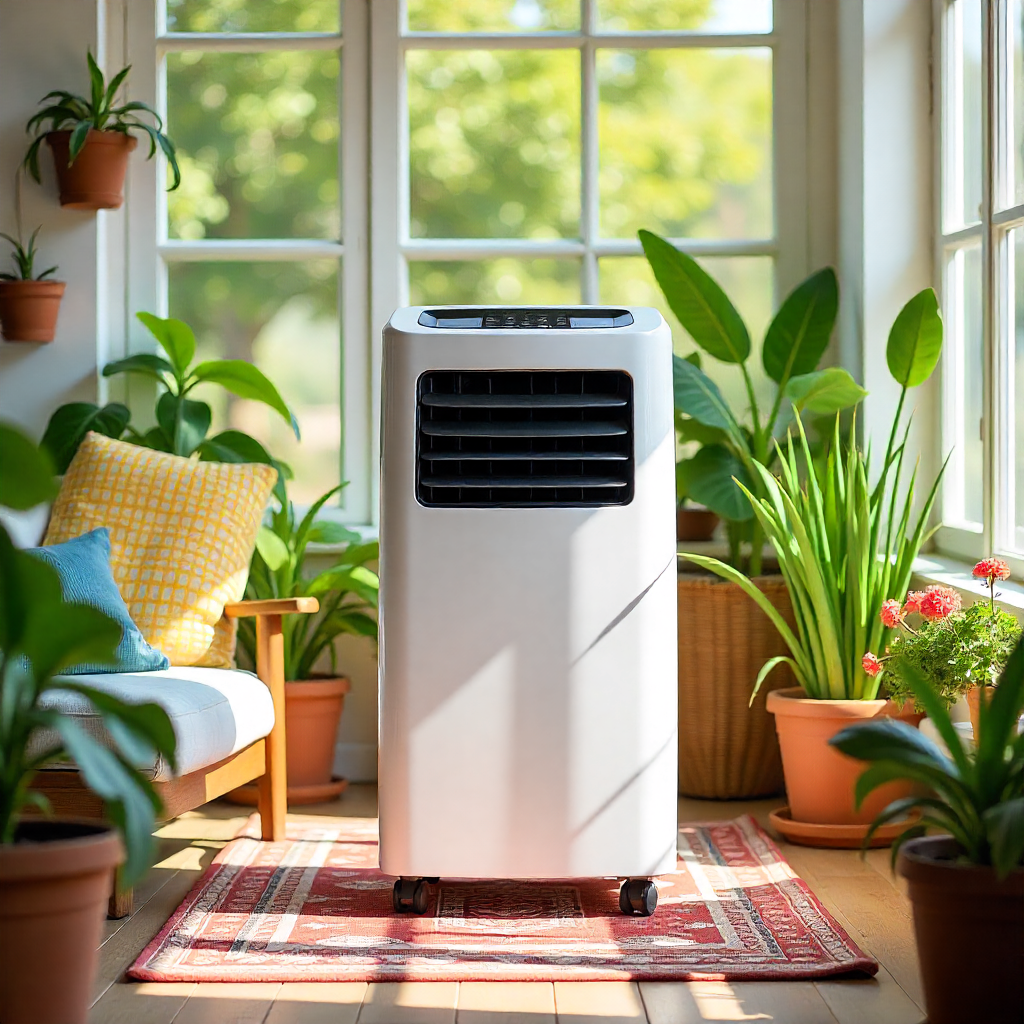
Window AC Placement
- Install in a shaded wall for better efficiency
- Ensure airflow is unobstructed
Split AC Placement
- Place high on the wall to cool evenly
- Avoid corners and heat sources
Common Installation Mistakes to Avoid
- Installing in direct sunlight
- Blocking airflow with furniture
- Incorrect height for cooling efficiency
Maintenance Tips to Extend AC Lifespan
- Clean Air Filters Regularly: Every 1–2 months
- Annual Servicing: Check compressor, refrigerant, and condenser
- Smart Usage Tips: Close doors/windows, use curtains, set optimal temperature 24–26°C. to know more check out our article Best Blue Star AC Maintenance Tips
Buying Checklist – Blue Star AC Models for Small Rooms
- Measure your room size accurately
- Check energy rating and inverter technology
- Evaluate noise levels for comfort
- Look for filters and additional features
- Compare prices and warranty coverage
- Plan installation location
- Follow maintenance tips for longevity
FAQs -Blue Star AC Models for Small Rooms
1: What is the ideal AC capacity for a small room?
For Blue Star AC Models for Small Rooms, a 0.8 to 1-ton AC should suffice, depending on room size and ambient temperature.
2: How can I reduce the electricity bill with a Blue Star AC?
Opting for Blue Star AC Models for Small Rooms with higher star ratings (4-5 stars) and inverter technology can help reduce energy consumption significantly.
3: Are Blue Star ACs suitable for very small rooms?
Yes, Blue Star AC Models for Small Rooms, like the 0.8-ton window AC, are specifically designed for compact spaces.
4: Is it worth investing in a 5-star rated Blue Star AC?
Yes, investing in Blue Star AC Models for Small Rooms with a 5-star rating offers long-term savings due to better energy efficiency.
5: Can I install a Blue Star inverter AC myself?
It’s recommended to get professional installation for Blue Star AC Models for Small Rooms like inverter ACs to ensure optimal performance and warranty coverage.check our our 7 Easy Steps for Blue Star AC Installation guide

